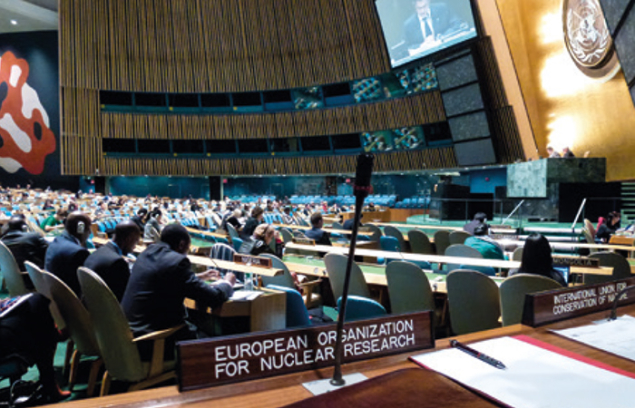
Image credit: Maurizio Bona/CERN.
Today, science, technology and innovation are among the most powerful forces driving social change and development. However, what is the actual role that a fundamental science laboratory like CERN can have when it comes to designing creative strategies to strengthen public goods in society?
With a view to contribute to the realisation of the 2030 Agenda for Sustainable Development, which was approved in September by the United Nations Member States, the United Nations Office at Geneva (UNOG) hosted a one-day symposium organised in collaboration with CERN and with the support of Switzerland and France, in their capacity as CERN host states.
Air, water, biodiversity, education, knowledge, access to the Internet, peace and welfare: these public goods can be preserved only with the involvement of all stakeholders. At the event, policy makers, diplomats, ambassadors, scientists, intellectuals, epistemic associations, representatives of international governmental and non-governmental organisations, and civil-society representatives explored the value of CERN as a model for co-operation.
CERN is a recognised example of peaceful international collaboration based on transparency, openness and inclusion. The invention of the World Wide Web is emblematic of the spirit that drives advances in basic science, which enable open innovation and education, and connect the worldwide community through shared values. A typical scientific community is self-organised and able to share the infrastructure needed by all. The centrality of knowledge (scientific arguments in global policy), long-term thinking, agile project and risk management, even under harsh conditions of unpredictability, smart governance and social networking, big data, considering alternative scenarios – these are all features and “goods” that belong to the scientific world but that also play a role in different contexts.
Necessary compromises
The UN world has an impressive infrastructure that ensures global governance, including the UN Secretariat, the General Assembly and the Economic and Social Council. These structures permitted a global consultation process that led to the formulation and adoption of the 2030 agenda, with its 17 sustainable-development goals and 169 targets. The complexity of the governance of such an important process is the result of necessary compromises. It is everybody’s duty to make it efficient and capable of addressing the difficult global challenges the world is now facing. CERN can contribute by explaining its functioning model and by providing, when needed, direct input on science, technology and education.
About one week after the symposium at UNOG, CERN and the World Academy of Arts and Sciences (WAAS) hosted another one-day conference to discuss the topic of “Science, technology, innovation and social responsibility”. The event was organised under the auspices of UNOG and saw the participation of the EPS and some Geneva-based international organisations, including the International Labour Office (ILO), World Health Organization (WHO), United Nations Institute for Training and Research (UNITAR), World Meteorological Organization (WMO), International Organization for Standardization (ISO) and World Intellectual Property Organization (WIPO). The specific objective was to survey the potential impact of scientific and technological innovation in different fields on the progress of humanity, independent of political boundaries or limits, whether spiritual or physical.
Lively discussions took place around the topic of social responsibility that comes with self-governance of the scientific community. Obviously, this is of particular relevance when it comes to dealing with health-related issues. In particular, fighting certain types of disease requires a strong collaboration between the scientific community, governments and companies producing vaccines. But scientific and technological developments also have a huge impact on the labour market. In this respect, science and society are not sufficiently synchronised, and future planning needs to be better co-ordinated. In fields such as meteorology, scientific co-operation is accepted as essential, because without it every country would lose: predictions and warnings are possible only with global exchange of data.
All of these initiatives show the importance of keeping the dialogue between scientists, diplomats, policy makers, business experts and the public at large constantly alive. Since the very beginning of the scientific venture that gave birth to CERN, people from different cultures, religions and political opinions could speak the common language of science. In this scenario, peace appears as a natural consequence and becomes an attitude. More than 60 years of peaceful and fruitful collaboration are the tangible result that science can indeed serve as a successful model to follow.
A video recording of “The CERN model, United Nations and Global Public Goods: addressing global challenges” is available at webtv.un.org/watch/panel-1-the-cern-model-science-education-and-global-public-good-cern-unog-symposium-2015/4590293913001. A video recording of the “Science, technology, innovation and social responsibility” conference is available at cds.cern.ch/record/2103652.





